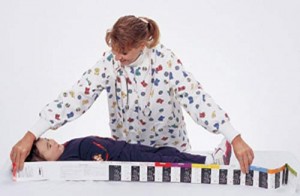
The primary objective of this study was to assess the field performance of the Broselow tape and the Handtevy method with respect to prehospital pediatric patient weight estimations. 12, 17, 22 There appear to be no studies in the published literature evaluating the accuracy of the Handtevy weight estimation method in the prehospital setting. 21 There are few studies evaluating the Handtevy system, most of which were published prior to the development of the solely age-based application, however Rappaport, et al recently published a manuscript reporting almost 90% dosing accuracy using the Handtevy Field Guide (accuracy was based on correct use of the field guide/patient age, not patient weight). The Handtevy system, initially developed in 2010 as a length and age-based system, has been adapted and can now be used as an exclusively age-based tool for weight estimation. The Broselow method was developed in the 1980s and has been modified and studied fairly extensively in the intervening years, with varying results. 5 The Broselow method, which provides a weight estimation based on length as measured using the Broselow tape, is the most commonly used length-based tape. Many tools have been developed to assist with pediatric weight estimation, including age-based formulas, length-based tapes, paperboard dosing wheels, and electronic applications. However, in prehospital care, obtaining reliable weight measurements is not straightforward it is estimated that approximately 20% of out-of-hospital pediatric weight estimates are not accurate. As pediatric medication dosing is predominantly weight-based, accurate assessment is essential. 1 Many of the complications inherent to pediatric medication dosing are potentiated by the unpredictable nature of the prehospital setting.

Pediatric medication errors have been attributed to a number of causes, including weight-based dosing and the increased number of calculations required for correct dosing and administration. 2– 4 These errors are estimated to affect over 21,000 US children under the age of 11 each year. 1 Medication errors have been shown to occur more frequently in the emergency department (ED), and error rates rise even further in the prehospital setting to just under 35% for all medications and over 60% for epinephrine. In the pediatric in-patient setting, Kaushal, et al reported an error rate of approximately 55 errors for every 100 admissions, the majority (28%) being dosing errors, and a potential adverse drug event rate of 10/100 admissions. A prospective study is needed to test this method with the Broselow Tape in an acute hospital setting.Medication errors in the pediatric patient population are quite prevalent. Conclusion: The Broselow Tape underestimated the weights of both overweight and obese patients, suggesting the need for adjustment of the length-based dosing zones for overweight and obese patients. Obese patients had a one-zone misclassification rate of 71% and a two-zone misclassification rate of 23%. Overweight patients had a one zone misclassification rate of 83%. Results showed that the misclassification rate of Broselow Tape increases with BMI percentile values. Results: Percent of true classification and misclassification of body weight zones was calculated for each BMI percentile category.

SAS 9.4 was used for all statistical analyses with an alpha level of 0.05 to assess statistical significance. Heights and weights were recorded and compared to predicted Broselow Tape weight. Subjects were placed into groups according to the CDC guidelines of BMI percentile categories: underweight, normal, overweight, obese.


Methods: A retrospective chart review was performed using the electronic medical records at the Children’s Hospital of Georgia in Augusta University, between May 2015- March 2018. It was hypothesized that the predicted weight needed adjustment by at least color zone for obese and overweight patients in order for them to receive adequate medication during emergency. This study aims to determine the accuracy of the Broselow Tape among pediatric patients with a body mass index (BMI) greater than the 85th percentile. The rise of childhood obesity in the United States, with a prevalence of 18.5% in 2016, has brought up recent concerns for underestimation of weight using the Broselow Tape. Introduction: The Broselow Tape is a color-coded tape that uses height to predict weight-based dosage of medications and equipment sizes in order to safely treat pediatric patients in medical emergencies.


 0 kommentar(er)
0 kommentar(er)
